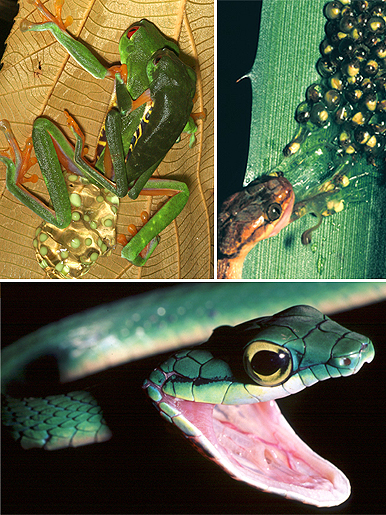Escape hatching
Tree frog embryos flee eggs when predators call

In the jungles of Central America, spiders, wasps, snakes, and other predators feast on red-eyed tree frog eggs that sit in gelatinous clutches attached to vegetation overhanging ponds. At least half of all embryos never live to be tadpoles.
Life is precarious for tree frogs, and according to Karen Warkentin, a College of Arts and Sciences assistant professor of biology, they know it even before they’re born. Warkentin has found that tree frog embryos still inside eggs can sense the vibrations of an attacking predator and hatch early to escape into the water. Her most recent findings, that these embryos perceive a very narrow band of vibration patterns as indicating danger, are published in the current Journal of Experimental Biology.
Tree frog eggs normally hatch into tadpoles that drop into the water and continue their development about six to eight days after fertilization. But, in a move that Warkentin calls “escape hatching,” tree frog embryos that sense danger can wiggle out of their jelly-coated eggs up to 30 percent earlier than normal. (Click here to see a video of a snake attacking a clutch of tree frog eggs, inducing many embryos to hatch early.)
To test her theory that the escape hatching mechanism was triggered by vibration as opposed to the sight, sound, or smell of a predator, Warkentin ventured into the Panamanian jungle and plucked leaves containing egg clutches, which she took to an open-air lab of the Smithsonian Tropical Research Institute.
She inserted an “electrodynamic shaker,” a device that generates movements, not just sound, into the egg clutches and exposed them to “dangerous” vibration recordings of actual snake attacks and “harmless” vibration recordings of rainstorms. Sure enough, the tree frog embryos hatched early more often in response to snake-attack vibration recordings than to rainstorm recordings.
“That told me that [the embryos] are paying attention to vibrations, and also that it’s not just any vibrations,” says Warkentin, who published these results last year in the journal Animal Behaviour. “They’re actually making some distinction between the vibrations.”
And yet, jumping into the water early is risky for tree frog embryos, because it leaves them more vulnerable to other predators, including fish and shrimp. Warkentin wanted to find out how finely tuned in the embryos are to vibration variables — such as duration, intervals, and frequency — when they hear vibrations that may or may not indicate danger.
In general, vibrations produced by an attacking snake are longer than vibrations produced by raindrops. Plus, the intervals between the snake vibrations tend to be longer than those between rain vibrations because, as Warkentin notes in her most-recent article, “the snake has to swallow a mouthful of eggs between bites.”
When Warkentin played the eggs varying “temporal patterns” of synthesized white-noise vibration using differing durations and intervals, the results revealed that the embryos hatched prematurely only in response to a very narrow range of patterns. For instance, .5-second bursts combined with 1.5- to 2.5-second gaps caused nearly 75 percent of the embryos to hatch early. But only about half hatched when the vibration duration was dropped to .25 seconds with those same gaps. And only about a third hatched when the durations were held at .5 seconds but the gaps were lengthened to 5 seconds.
“This really shows that the embryos are quite precise in the range of vibrations that they perceive as scary and dangerous,” says Warkentin.
Michael Caldwell (GRS’08), a biology doctoral student and one of Warkentin’s research associates, says that it demonstrates that embryos, often thought of as very passive, respond to the outside world. “We may have to change our thinking and realize that embryos do have behavior,” says Caldwell, who coauthored the Journal of Experimental Biology paper along with J. Gregory McDaniel, a College of Engineering associate professor of aerospace and mechanical engineering, and Warkentin.
In addition to differences in temporal pattern, Warkentin believes the frequency of vibrations also plays a major role in the embryos’ escape hatching behavior, but she has yet to test that variable. It’s one of several next steps she plans for upcoming experiments.
“We also don’t know what sensors they’re using,” she notes. “So, how are they even perceiving these vibrations?”
While there are still many unanswered questions, Warkentin is excited about the potential of vibration research. “These playback experiments essentially give us a window into the brains of these eggs, to assess what their information processing capabilities are,” she says. “We can essentially ask them, can you distinguish between these two things? And what do you perceive as scary?”